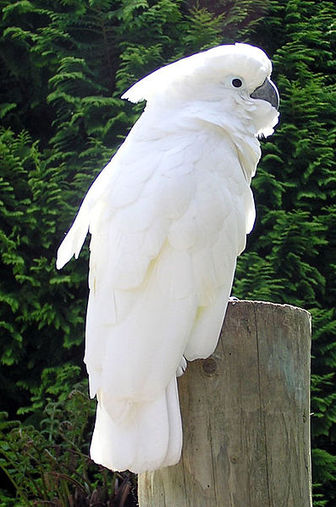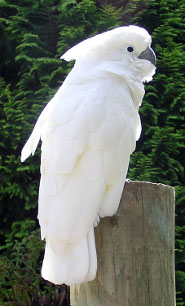White Cockatoo
The White Cockatoo can live up to, and perhaps beyond, 80 years.

The White Cockatoo - Smart, affectionate and almost gone
 The White Cockatoo (Cacatua alba) is indigenous to several islands of Indonesia. It is also called the Umbrella Cockatoo because it has a large crest which resembles an umbrella. It is 10 centimeters (4 inches) long and is opened when the bird is surprised. It has white outer feathers, black or brown eyes and a dark gray beak, but when it flies it flashes lemon yellow feathers that are under its wings and tail.
The White Cockatoo (Cacatua alba) is indigenous to several islands of Indonesia. It is also called the Umbrella Cockatoo because it has a large crest which resembles an umbrella. It is 10 centimeters (4 inches) long and is opened when the bird is surprised. It has white outer feathers, black or brown eyes and a dark gray beak, but when it flies it flashes lemon yellow feathers that are under its wings and tail.
White Cockatoos make good pets because they are affectionate and bond with humans. They like to cuddle with their owners. Because they are highly intelligent, they are often used in animal acts and magic shows. They can imitate human speech but are not the best speakers among parrots.
Because of their popularity as a pet they are exploited to an unsustainable level and are considered Vulnerable VU by the IUCN Red List of Threatened Species. The number of these birds that live in the wild is reducing rapidly.
White Cockatoos are approximately 46 centimeters (1.51 feet) long and require large primary forests for nesting and roosting. These forests include mangroves, coconut and other plantations as well as agricultural land which show that they can live in several different types of habitats. Usually they like small groups in the tree tops. They weigh from 500 to 630 grams (1.1 to 1.39 pounds) and their wingspan is 25 to 31 centimeters (9.84 to 12.2 inches) on average.
The hen lays two eggs that hatch in 30 days. Both parents will feed the chicks until they reach three months old. Reproduction starts at five years and they usually live up to 20 years but, in some cases, up to 80 years. They mate for life and can show very depressed behavior if they are separated from their mate.
In the wild they eat fruits such as durian, langsat, papaya and rambutan as well as seeds and nuts. Also, crickets, skinks and maize in agricultural areas are part of their diet. They can do considerable damage to a maize crop. Some birds of prey may catch a White Cockatoo and, very rarely, large snakes and lizards.
These birds are very intelligent and use tools such as a small branch to scratch their back or beat on a tree to establish their territory. They are great mimics in captivity and require a lot of attention. They play with toys, are in constant motion doing gymnastics and demand the attention of the people in the room.
The White Cockatoo is classified as Vulnerable (VU), considered to be facing a high risk of extinction in the wild.

Original source: Krimpet
Author: Krimpet
Permission: Some rights reserved
Family : Psittacidae
Genus : Cacatua
Species : alba
Authority : (Müller, 1776)

